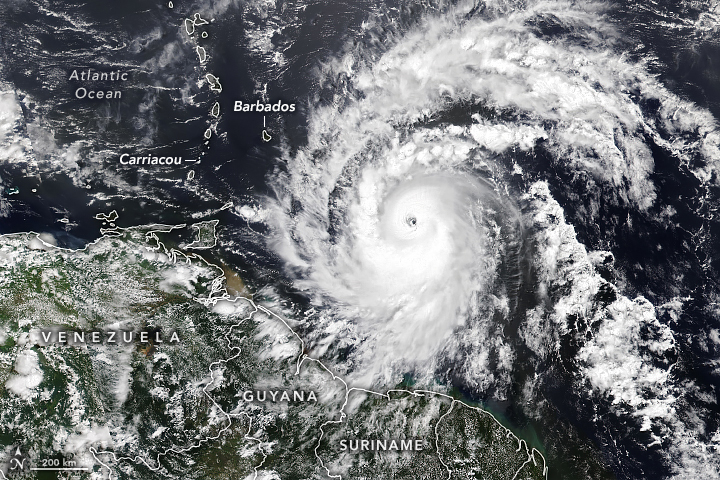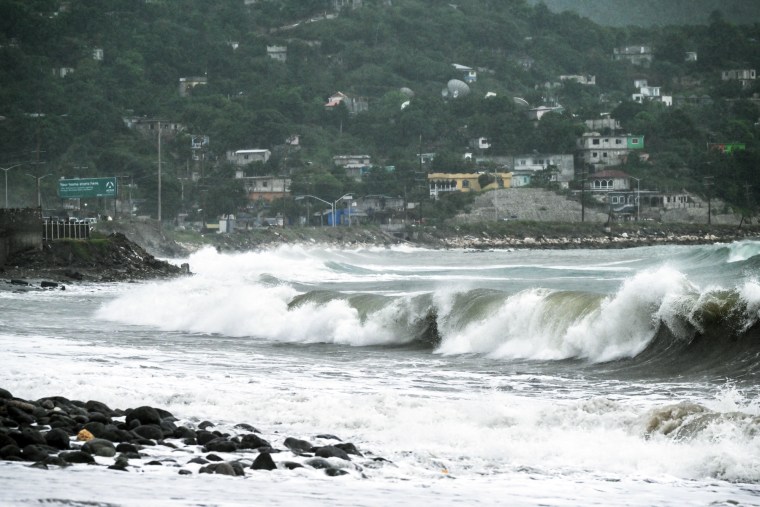Hurricane Melissa: Category 5 Storm Threatens Jamaica with Catastrophic Impact
Hurricane Melissa: Category 5 Storm Threatens Jamaica with Catastrophic Impact

Hurricane Melissa has rapidly intensified into a catastrophic Category 5 storm with sustained winds of 160 mph, threatening Jamaica with what could be the strongest hurricane to directly strike the island nation in recorded history. As of Monday, October 27, 2025, the massive storm is centered approximately 130 miles south-southwest of Kingston, moving at a dangerously slow pace of just 3 mph—a speed that will amplify flooding devastation across the Caribbean.
⚠️ EMERGENCY ALERT
The National Hurricane Center warns residents to "seek shelter now." Damaging winds and catastrophic flooding are already underway, with the worst impacts expected Monday night through Tuesday.
Current Storm Status and Trajectory
Hurricane Melissa achieved Category 5 status—the highest classification on the Saffir-Simpson scale—early Monday morning after undergoing extreme rapid intensification over exceptionally warm Caribbean waters. The storm's hurricane-force winds extend outward up to 30 miles from the center, creating a wide zone of destruction.

The storm is forecast to make landfall on Jamaica Monday night into Tuesday morning before tracking across southeastern Cuba and the Bahamas through Wednesday. Forecasters at the Miami-based National Hurricane Center emphasize that "preparations to protect life and property should be complete in Jamaica and rushed to completion in Cuba."
Unprecedented Rainfall and Flooding Threats
The most alarming aspect of Hurricane Melissa is its crawling forward speed, which will dump catastrophic rainfall amounts over the same areas for days. Rainfall totals are expected to reach 30 inches across parts of Jamaica, with local maximum amounts potentially hitting 40 inches in mountainous eastern regions. Western Haiti could receive 16 inches, while eastern Cuba faces up to 20 inches of rain.
Evan Thompson, principal director at Jamaica's Meteorological Service, warned that cleanup and damage assessment will be severely delayed because of anticipated landslides, flooding, and blocked roads. "There is nowhere that will escape the wrath of this hurricane," Thompson stated. "It's going to sit there, pouring water while it's barely moving and that is a significant challenge."
Why Melissa's Slow Movement Is So Dangerous
When hurricanes crawl at such slow speeds, rainfall accumulates over the same towns and cities for extended periods. This setup mirrors the catastrophic scenarios of Hurricane Harvey in 2017, which dumped over four feet of rain on parts of Texas, and Hurricane Dorian in 2019, which caused devastating floods in the Bahamas and South Carolina. Jamaica's steep mountainous terrain will force air upward, wringing out even more moisture from the storm—like squeezing a wet sponge—turning tropical humidity into torrents racing downhill with deadly force.
Life-Threatening Storm Surge and Wind Damage

In addition to torrential rainfall, Melissa will generate a life-threatening storm surge along Jamaica's southern coast. Peak surge heights could reach 9 to 13 feet above ground level, near and to the east of where the storm's center makes landfall. This surge will be accompanied by large, destructive waves capable of demolishing coastal structures and flooding inland areas.
Category 5 winds exceeding 157 mph possess catastrophic strength capable of destroying many homes in the storm's path. The most extreme winds will likely occur as Melissa tracks near Jamaica Monday into Tuesday, bringing downed trees, widespread power outages, and structural damage across the island. Jamaica's Minister of Transport, Daryl Vaz, urged residents: "Don't make foolish decisions. We are in a very, very serious time over the next few days."
Emergency Response and Evacuations
The Jamaican government issued mandatory evacuation orders Sunday evening for several vulnerable coastal communities, including parts of Kingston. Emergency shelters have been activated across the country for people living in flood-prone and low-lying areas. All public hospitals entered "emergency mode" since Thursday evening, halting outpatient and elective procedures to ensure more beds are available for storm-related injuries.

Both of Jamaica's international airports—Norman Manley International Airport and Sangster International Airport—have closed operations. Prime Minister Andrew Holness advised citizens: "Now is the time to secure your home, check your roof, windows, and surroundings. Use sandbags or plywood where needed and clear any overhanging branches safely. If you live in a flood-prone area, take protective measures and have an evacuation plan ready."
Regional Impact Beyond Jamaica
Hurricane Melissa has already claimed at least four lives—three in Haiti and one in the Dominican Republic—with another person reported missing. The storm damaged more than 750 homes across the Dominican Republic, displacing over 3,760 people, while floodwaters have cut access to at least 48 communities.
A hurricane warning is in effect for eastern Cuba's provinces of Granma, Santiago de Cuba, Guantánamo, and Holguín. The Bahamas government has issued a hurricane watch for the central and southeastern Bahamas and the Turks and Caicos Islands. While the United States mainland is not expected to be directly threatened, rough surf and dangerous rip currents could spread along the East Coast next week.
Climate Change Connection
Melissa's explosive strengthening over the weekend represents a troubling trend: extreme rapid intensification is happening more frequently as the world warms due to fossil fuel pollution. The Caribbean's exceptionally warm water extends far below the surface, preventing the usual "stirring up" of cooler water that typically weakens hurricanes. Melissa has been able to feast on this deep reservoir of heat, raising the ceiling on its potential intensity. Three of the four Atlantic hurricanes this season—Erin, Gabrielle, and Humberto—underwent similar extreme rapid intensification patterns.
Frequently Asked Questions
How strong is a Category 5 hurricane?
Category 5 is the highest classification on the Saffir-Simpson hurricane wind scale, indicating sustained winds of at least 157 mph. These storms possess catastrophic strength capable of destroying most frame homes, uprooting trees, causing widespread power outages lasting weeks or months, and rendering areas uninhabitable for extended periods.
Why is Melissa's slow movement so dangerous?
Hurricane Melissa is moving at just 3 mph—slower than walking speed. This crawling pace means the storm will dump rainfall over the same locations for days rather than hours, leading to accumulation totals that far exceed what typical hurricanes produce. The extended rainfall dramatically increases flooding and landslide risks, especially in mountainous terrain.
When will Hurricane Melissa make landfall in Jamaica?
The National Hurricane Center forecasts Hurricane Melissa will make landfall on Jamaica Monday night (October 27) into Tuesday morning (October 28, 2025). However, life-threatening conditions including tropical storm-force winds and heavy rainfall are already impacting the island as of Monday morning.
How much rain will Hurricane Melissa bring?
Jamaica and southern Hispaniola are expected to receive 20-30 inches of rain through Tuesday, with localized maximum amounts reaching 40 inches in mountainous areas. Eastern Cuba could see up to 20 inches. These extraordinary rainfall totals will cause catastrophic flash flooding and numerous landslides across the region.
Is the United States at risk from Hurricane Melissa?
The U.S. mainland is not expected to experience direct impacts from Hurricane Melissa. However, rough surf and dangerous rip currents could spread along the East Coast next week as the storm moves through the Caribbean. Residents and visitors to coastal areas should monitor local forecasts and heed warnings from lifeguards.
What You Can Do Now
If you have family or friends in Jamaica, Haiti, Cuba, or other affected Caribbean islands, reach out to check on their safety and evacuation plans. Monitor trusted sources like the National Hurricane Center, local meteorological services, and official government channels for the latest updates. Residents in the path of Hurricane Melissa should have already completed all preparations and be sheltering in safe locations away from flood-prone areas and coastal zones.

Desmond McKenzie, deputy chairman of Jamaica's Disaster Risk Management Council, urged citizens: "I want to urge Jamaicans to take this seriously. Do not gamble with Melissa. It's not a safe bet." This sentiment applies to everyone in the storm's path—when forecasters warn of "catastrophic" and "life-threatening" conditions, they mean exactly that.
📢 Stay Informed and Share This Critical Update
Hurricane Melissa represents an extraordinary threat to the Caribbean. Share this article with anyone who needs to know about this dangerous storm. Stay safe, follow evacuation orders, and monitor official weather channels for the latest information.